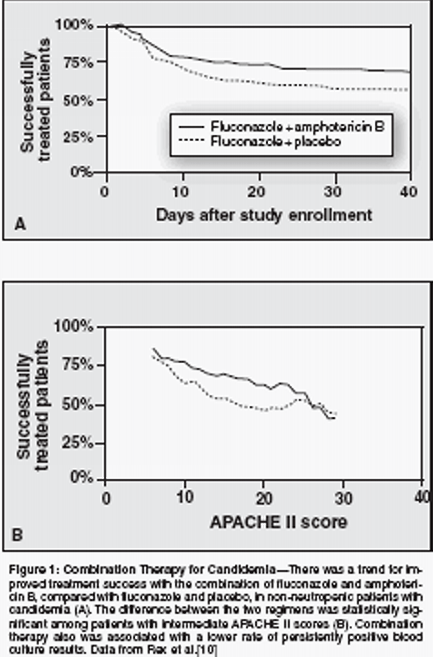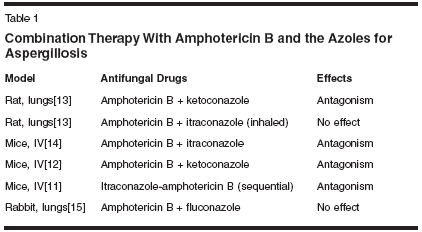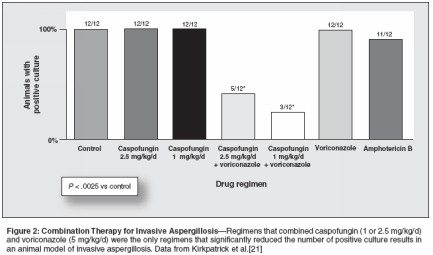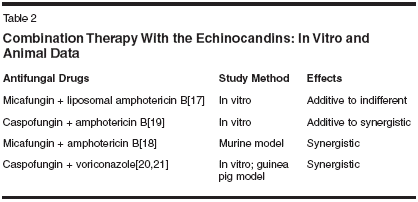Combination Antifungal Therapy: Where Are We Now, and Where Are We Going?
Combination therapy with amphotericin B and flucytosine is consideredto be the treatment of choice for cryptococcal infections. However,for other infections and combinations of antifungal infections,the data are less clear-cut. The concurrent use of amphotericin B withan azole has elicited controversy, given the potential of antimicrobialantagonism. The results of one recent candidemia study suggest thatthe potential antagonism may not be an issue; the combination of amphotericinB and fluconazole provided more effective clearance of Candidafrom the bloodstream than did fluconazole used alone. Several invitro and animal studies have shown antagonism between the azolesand amphotericin B for aspergillosis. However, introduction of the newclass of agents that target β-glucan synthase (echinocandins) has invigoratedthe prospects of combination therapy. The echinocandins andpolyenes are not antagonistic, and there is evidence that theechinocandins may provide additive to synergistic activity in combinationwith triazoles. For patients whose aspergillosis is progressing despitemonotherapy, the addition of a second agent, such as anechinocandin, may be reasonable.
ABSTRACT: Combination therapy with amphotericin B and flucytosine is consideredto be the treatment of choice for cryptococcal infections. However,for other infections and combinations of antifungal infections,the data are less clear-cut. The concurrent use of amphotericin B withan azole has elicited controversy, given the potential of antimicrobialantagonism. The results of one recent candidemia study suggest thatthe potential antagonism may not be an issue; the combination of amphotericinB and fluconazole provided more effective clearance of Candidafrom the bloodstream than did fluconazole used alone. Several invitro and animal studies have shown antagonism between the azolesand amphotericin B for aspergillosis. However, introduction of the newclass of agents that target β-glucan synthase (echinocandins) has invigoratedthe prospects of combination therapy. The echinocandins andpolyenes are not antagonistic, and there is evidence that theechinocandins may provide additive to synergistic activity in combinationwith triazoles. For patients whose aspergillosis is progressing despitemonotherapy, the addition of a second agent, such as anechinocandin, may be reasonable.
The concept of combinationtherapy for the treatment of infectiousdiseases is certainlynot new. Combinations of drugshave been administered as singleformulations (eg, trimethoprimsulfamethoxazole)and as multidrugregimens for many years. Combinationantifungal therapy has the potentialadvantage of improving outcomesof infection by increasing microbialkilling, providing different tissue distributions,and allowing for dose adjustmentsof drugs that have concentration-related toxicities. However,with few exceptions, the utility ofcombination antifungal therapy hasnot yet been well documented in largeclinical trials.Because systemic fungal infectionsare most often observed in patientswho are immunocompromised, theterm "combination antifungal therapy"could be loosely interpreted tomean a combination of an antifungaldrug with an immunomodulatingagent. However, in its strict sense,combination antifungal therapy refersto the combination of two or moreantifungal drugs, which is the focusof this article.BackgroundFungi may be unicellular organisms(eg, yeasts) or multicellularfilamentous organisms (eg, molds),generally characterized by thepresence of a chitin and glucan-containingcell wall and an ergosterolcontainingcell membrane. Each ofthese structures may be the site ofaction of a particular class of antifungalagent.The polyenes (amphotericin B, lipidformulations of amphotericin B,and nystatin) bind to ergosterol in thecell membrane, thereby destabilizingthe membrane and causing leakage ofcellular components. The azoles (fluconazole,ketoconazole, itraconazole,and voriconazole) act within the cellto inhibit ergosterol synthesis so thatthe cell membrane produced duringcell division is inadequate. Theantimetabolite flucytosine, or 5-fluorocytosine,is a water-soluble, fluorinatedpyrimidine analog. Once takenup by the microbial cell, 5-FC is convertedto 5-fluorouracil, which inhibitsthe synthesis of both DNA andRNA. The echinocandins are members of a new class of compounds thatinhibit the synthesis of an essentialpolysaccharide-1,3,beta-D-glucan-in the cell wall of select fungi.There are potential theoretical advantagesand disadvantages to usingtwo or more antifungal drugs.Potential Advantages
The potential advantages of combiningantifungal agents are as follows:
- An increase in antimicrobial activitysecondary to an increase in boththe rate and the degree of microbialkilling.
- A decrease in microbial drugresistance.
- An increase in the spectrum ofactivity, particularly applicable to infectionsin which the exact identity ofthe infecting fungus is unknown.
- Enhancement in the tissue distributionof the two drugs, an importantconsideration in certaindisseminated CNS infections.
- Reduction in drug-related toxicity,particularly if the dosage of adrug that has dose-related toxicitiescan be reduced.
Potential Disadvantages
The potential disadvantages ofcombination therapy include the following:
- Antagonism between the twodrugs, so the activity of one or bothdrugs is reduced.
- An increase in the potential fordrug-related toxicity.
- Increased risk of drug-drug interactions.
- Increased cost compared withsingle-drug therapy.
Antagonism between two antimicrobialdrugs may occur because ofeither an interference with the mechanismof activity or an adverse effecton drug metabolism. Either of theseevents would adversely affect theavailable concentration of drug, sothat microbial resistance might be induced.

Combination AntifungalTherapy
Before any consideration is givento combining antifungal drugs, it isimperative that the mechanisms ofaction and the metabolism of eachantifungal agent be understood. Ourknowledge of combination therapy islimited; however, we do have the benefitof experience with different agentsused in different infections and, inmost cases, we know how the individualagents attack fungi.
Amphotericin B and Flucytosinefor Cryptococcal Infections
In patients with cryptococcal infections,the standard of care is theuse of flucytosine plus amphotericinB. It is well known that flucytosineshould not be used alone because microbialresistance against this agentdevelops relatively frequently. Also,flucytosine has dose-limiting toxicities,particularly targeting the bonemarrow. Early in vitro studies of
Cryptococcusneoformans
showed thatwhen flucytosine was combined withamphotericin B, the effect was at leastadditive and possibly synergistic.One interesting clinical study innon-HIV-infected patients who had
C neoformans
infection demonstratedthat a relatively high dose of flucytosine(150 mg/kg) in combinationwith a relatively low dose of amphotericinB (0.3 mg/kg), given for 6weeks, was associated with a fasterresponse and a higher cure rate thanthose achieved with amphotericin B(0.4 mg/kg) given alone for a longerperiod.[1] This study set the stage forlater studies of cryptococcal infectionsin patients with AIDS.The first study in patients with HIVinfection was a retrospective analysis.Surprisingly, it reported that flucytosine,at doses varying from 75 to100 mg/kg, plus amphotericin B didnot affect survival but was associatedwith increased drug toxicity.[2] However,the findings from a small prospectivetrial suggested that theoutcomes were better with a combinationof flucytosine (at a dose of 150mg/kg) and amphotericin B (at a doseof 0.7 mg/kg).[3]No definite conclusions can bedrawn from these trials, but the conflictingmessages generated by the retrospectivestudy and the small,prospective clinical trial supported theperformance of a definitive clinicaltrial examining one- vs two-drug therapyfor the treatment of cryptococcalmeningitis in patients with AIDS. Fourhundred patients with AIDS and cryptococcalinfection were randomizedto receive either amphotericin B (0.7mg/kg) plus flucytosine (100 mg/kg)or amphotericin B alone for 2weeks.[4] After 2 weeks, patients whowere stable or who had shown improvementwere further randomizedto receive either high-dose itraconazole(400 mg/d) or high-dose fluconazole(400 mg/d) as "consolidationtherapy."

At the end of 2 weeks, no statisticallysignificant differences in mortalityrates or symptoms were notedwith the combination therapy comparedwith monotherapy.[4] However,there was a trend toward a bettercomposite success rate with combinationtherapy: 60% of the patients inthe combination-therapy group hadcerebrospinal fluid (CSF) culture resultsthat were negative for
C neoformans,
compared with 51% of thepatients in the monotherapy group(
P
= .06). Also, the mean openingCSF pressure on lumbar puncture waslower in the patients who had negativecultures.Both a negative culture result andlower CSF opening pressure are associatedwith better outcomes in patientswith cryptococcal meningitis, and, forthis reason, the combination of amphotericinB and flucytosine is nowconsidered first-line therapy for thesepatients. The consolidation phase ofthe study showed that fluconazole wasassociated with a higher rate of sterileCSF than was itraconazole, but thedifference was not statistically significant.[4]The various studies and trials inpatients with cryptococcal infectionshave reinforced the concept that retrospectiveanalyses are inherentlyflawed because of treatment bias andthe many uncontrolled variables thatare not accounted for. Randomizedtrials have indicated that the clinicalresponse to a combination of drugsmay depend on both the doses usedand the duration of use. Also, surrogateend points must be evaluated in studies that may not be adequatelypowered to demonstrate differencesin survival. In the cryptococcosis studies,better outcomes were associatedwith the higher dose of amphotericinB and the lower dose of flucytosine,given for a shorter duration than inprevious studies. Most likely, the successof therapy depends on both microbialkilling and host toxicities.
Amphotericin B and Azoles inCandida Infections
The use of amphotericin B with anazole antifungal agent is somewhatcontroversial.[5-7] Because the polyenes,such as amphotericin B, bind toergosterol in the cell membrane andthe azoles inhibit the synthesis of ergosterol,it had been proposed thatcombining the two types of drugswould be less effective than monotherapy.Both in vitro and animal studieshave yielded conflicting results as towhether amphotericin B and an azoleare actually antagonistic.[5,6,8,9] Theoutcome with this combination seemsto depend on the particular azole used,the sequence of administration, andthe animal model used. Sugar et al[5]found that combination therapy withfluconazole and amphotericin B wasnot antagonistic in a murine model ofinvasive candidiasis. In contrast, Louieet al[7] found evidence of antagonism.Another study found that itraconazoleand amphotericin B were antagonistic.[6]

In a randomized, blinded clinicaltrial that compared high-dose fluconazole(800 mg/d) with or without amphotericinB (0.7 mg/kg/d) innon-neutropenic patients with at leastone blood culture result positive for
Candida
species, combination therapywas associated with a lower rate ofpersistently positive blood culture results.[10] The success rate was slightlyhigher in patients treated withcombination therapy than in patientsreceiving fluconazole alone (Figure1). This study did not detect antagonismbetween fluconazole and amphotericinB; however, thecombination was more nephrotoxicthan fluconazole used alone.In this study, the difference betweenfluconazole used alone and fluconazolein combination withamphotericin B was related to theAPACHE II score.[10] Among patientswith the lower APACHE IIscores and those with the higherAPACHE II scores, no difference betweenthe response rates with combinationtherapy and monotherapy wasnoted. However, a difference wasclearly evident among patients whohad intermediate APACHE II scores,with those who received the combinationtherapy having higher responserates.These observations were interpretedto mean that the more intensivecombination therapy would not significantlyalter outcome for patientswith mild disease or for those withthe most severe disease-essentially,in those two populations, host factorswere driving clinical outcomes.[10]The fact that antagonism was not demonstratedis a very important finding.However, this combination is unlikelyto become a standard approach,given the increase in toxicities andthe availability of a new class of drugs(the echinocandins) that have activityagainst
Candida
species.
Amphotericin B and Azoles inAspergillosis
Based on in vitro and animal data,the combination of a polyene and anazole for aspergillosis is not well justified,except in the setting of diagnosticuncertainty. Several studiesusing various combinations of azolesand amphotericin B in different animalmodels of infection have shownantagonism between these types ofantifungal agents, and at least twostudies have failed to show an effect(Table 1).[11-15] Nevertheless, becauseof a pressing need to treat invasivemold infections, this combinationhas been used at times, largely forcedby clinical desperation.
Combination Therapy With NewerAgents: The Echinocandins
As noted previously, the echinocandins,of which caspofungin isthe first, inhibit synthesis of an essentialpolysaccharide in the cell wall, asopposed to having an effect on theergosterol in the plasma membrane.Hence, antagonism may not be an issue.Several in vitro studies of caspofunginand amphotericin B usedagainst
Candida
species and
Aspergillusfumigatus
used a checkerboarddesign.[16] With this design, the fractionalinhibitory concentration index(FICI) is calculated by dividing theminimal inhibitory concentration(MIC) of the combination of agentsby the MIC of each of the drugs.An FICI less than 0.5 indicates synergismof the combination, and anFICI greater than 4 indicates antagonismbetween the two antifungal agents. In one study that evaluatedthe combination of amphotericin Band caspofungin for A
fumigatus,
anFICI of 0.66 was documented, suggestingthat the combination was notantagonistic, possibly even approachingsynergism.Other in vitro studies have exploreda combination of various echinocandinscombined with polyenes or azolesagainst
Aspergillus
(Table 2). One invitro study showed that the activity ofa combination of the echinocandinmicafungin and liposomal amphotericinB was either additive or indifferent(ie, neither antagonistic norsynergistic).[17] However, in a murinemodel of invasive pulmonary aspergillosis,a combination ofmicafungin and amphotericin B wassynergistic.[18] In another in vitrostudy, a combination of caspofunginand amphotericin B had additive tosynergistic effects.[19] The combinationof caspofungin and voriconazolewas found to be synergistic in both anin vitro study[20] and a guinea pigmodel.[21]

In an in vitro study of the activityof a combination of voriconazole andcaspofungin against several differentspecies of
Aspergillus (Aspergillus fumigatus,Aspergillus terreus, Aspergillusflavus, and Aspergillus niger)
, noantagonism was demonstrated, and thecombination was additive in 42%, synergisticin 46%, and indifferent in 12%of isolates tested. The combination ofcaspofungin and voriconazole resultedin a reduction in the geometricmean MIC of each drug-from morethan 64 to 16 ?g/mL for caspofunginand from 1 to 0.25 μg/mL for voriconazole.[20]In a study of experimentally inducedinvasive aspergillosis in immunosuppressedguinea pigs,treatment included caspofungin (1 or2.5 mg/kg/d) with or without oral voriconazole(5 mg/kg/d), voriconazolealone, or amphotericin B (1.25 mg/kg/d).[21] Death occurred in 12 of 12untreated controls, compared with 4of 12 and 6 of 12 of the animals thatreceived caspofungin at 1 mg/kg/d and2.5 mg/kg/d, respectively, and 3 of 12of those treated with amphotericin B.No deaths occurred in the animalsgiven the combination of caspofunginand voriconazole or those givenvoriconazole alone.Given that the rates of survival withthe combinations of voriconazole andcaspofungin were no different fromthat with voriconazole alone, the questionnaturally arises as to the value ofadding caspofungin to voriconazole.In this study, the advantage of thecombination was demonstrated by areduction in colony counts in tissuesof animals treated with the combinationof drugs (Figure 2).[21]In addition to the above-describedin vitro and animal studies, a numberof small, retrospective clinical reportshave evaluated the efficacy of combinationantifungal therapy involvingthe echinocandins.An early study of caspofungin inpatients with pulmonary aspergillosiswas reported from the MemorialSloan-Kettering Cancer Center in NewYork.[22] In this retrospective study,the case records of 30 patients whohad acute leukemia complicated bypossible or proven pulmonary aspergillosiswere reviewed. All patientshad been treated with a combinationof caspofungin and either amphotericinB or liposomal amphotericin B.Sixty percent of patients had a favorableresponse to the addition of caspofungin,and 20% of patients whohad a favorable response had completeresolution of pulmonaryaspergillosis.One of the limitations of this studywas that only a minority of the patientshad proven invasive aspergillosis.A second limitation was thatcaspofungin was added to ongoingtherapy with amphotericin B at a medianof 12 days, which leads to thequestion of whether the timing of combinationtherapy affects the outcome.Finally, no comparator group wasused.Another study of 48 patients witheither documented invasive aspergillosis(23 patients) or probableinvasive aspergillosis (25 patients)was reported. In this cohort, the majorityof patients received a combinationof caspofungin and liposomalamphotericin B as salvage therapybecause of a failure of amphotericinB monotherapy during the previous 7or more days.[23] All patients wereimmunosuppressed: 50% had leukemia,and the remainder were allogeneictransplant recipients; 33% of thepatients had high APACHE II scores(16 or higher). The overall responserate was 42%. As with the previouslydescribed study, one of the limitationsof this study is that the diagnosiswas uncertain in a substantial numberof patients, and no comparator datawere available.These two studies suggest that largemedical centers that routinely treatimmunosuppressed patients are usingthese combinations quite aggressively,despite the current lack of controlleddata. Whether the combinationof the drugs has an advantage thatoutweighs the potential toxicities orprovides substantial benefit is currentlyunknown.What can be said about the echinocandinsis that the in vitro studies,the animal models, and the early clinicalstudies have provided verypromising results that support furtherexploration in randomized clinical trials to evaluate their use in aspergillosis.However, a randomized trial is avery complicated endeavor requiringcareful consideration of the drugs,doses, patient population, and endpoints. Such a trial would have toenroll a large number of patients. Forinstance, to show a 10% improvementwith the combination of voriconazoleand caspofungin compared with voriconazolealone, a minimum of 570evaluable patients would have to beenrolled; however, given the severityof the underlying disease in these patients,a higher sample size may haveto be initially used.
Conclusions
- Cryptococcosis-For cryptococcalinfections, the combination ofamphotericin B and a low dose offlucytosine is standard therapy, basedon results of a good randomized trial.
- Candidiasis-For the treatmentof candidiasis, a combination of amphotericinB and an azole probablyprovides more effective clearance ofthe organism from the bloodstreamthan does fluconazole alone. One candebate whether this combination isoptimal therapy in light of the availabilityof echinocandin antifungalsand the increased toxicities observed.
- Aspergillosis-For aspergillosis,convincing data as to the best initialtreatment are lacking. For patientswho are being treated with one agentand whose disease is progressing, itappears reasonable to add a secondagent, such as an echinocandin, or toswitch classes of antifungals. However,using combination therapy asprimary therapy is an untested hypothesis.Since drug-related toxicitiesmay negate the potential antimicrobialbenefits, a randomized trial for primarytherapy most certainly needs tobe performed.
Disclosures:
Dr. Marr has acted as aconsultant for Pfizer, Enzon, Fujisawa, Merck,and Vicuron.
References:
1.
Bennett JE, Dismukes WE, Duma RJ, etal: A comparison of amphotericin B alone andcombined with flucytosine in the treatment ofcryptococcal meningitis. N Engl J Med301:126-131, 1979.
2.
Chuck SL, Sande MA: Infections withCryptococcus neoformans in the acquired immunodeficiencysyndrome. N Engl J Med321:794-799, 1989.
3.
Larsen RA, Leal MA, Chan LS:Fluconazole compared with amphotericin Bplus flucytosine for cryptococcal meningitis inAIDS: A randomized trial. Ann Intern Med113:183-187, 1990.
4.
van der Horst CM, Saag MS, Cloud GA,et al: Treatment of cryptococcal meningitis associatedwith the acquired immunodeficiencysyndrome. N Engl J Med 337:15-21, 1997.
5.
Sugar AM, Hitchcock CA, Troke PF, etal: Combination therapy of murine invasivecandidiasis with fluconazole and amphotericinB. Antimicrob Agents Chemother 39:598-601,1995.
6.
Sugar AM, Liu X-P: Interactions ofitraconazole with amphotericin B in the treatmentof murine invasive candidiasis. J InfectDis 177:1660-1663, 1998.
7.
Louie A, Banerjee P, Drusano GL, et al:Interaction between fluconazole and amphotericinB in mice with systemic infection due tofluconazole-susceptible or -resistant strains ofCandida albicans. Antimicrob AgentsChemother 43:2841-2847, 1999.
8.
Louie A, Kaw P, Banerjee P, et al: Impactof the order of initiation of fluconazole andamphotericin B in sequential or combinationtherapy on killing of Candida albicans in vitroand in a rabbit model of endocarditis and pyelonephritis.Antimicrob Agents Chemother45:485-494, 2001.
9.
Sugar AM, Salibian M, Goldani LZ:Saperconazole therapy of murine disseminatedcandidiasis: Efficacy and interactions withamphotericin B. Antimicrob Agents Chemother38:371-373, 1994.
10.
Rex JH, Pappas PG, Karchmer AW, etal: A randomized and blinded multicenter trialof high-dose fluconazole plus placebo versusfluconazole plus amphotericin B as therapy forcandidemia and its consequences innonneutropenic subjects. Clin Infect Dis36:1221-1228, 2003.
11.
Polak A: Combination therapy of experimentalcandidiasis, cryptococcosis, aspergillosisand wangiellosis in mice. Chemotherapy33:381-395, 1987.
12.
Schaffner A, Frick PG: The effect ofketoconazole on amphotericin B in a model ofdisseminated aspergillosis. J Infect Dis151:902-910, 1985.
13.
Schmitt HJ, Bernard EM, Edwards FF,et al: Combination therapy in a model of pulmonaryaspergillosis. Mycoses 34:281-285,1991.
14.
Schaffner A, Bohler A: Amphotericin Brefractory aspergillosis after itraconazole: evidencefor significant antagonism. Mycoses36:421-424, 1993.
15.
George D, Kordick D, Miniter P, et al:Combination therapy in experimental invasiveaspergillosis. J Infect Dis 168:692-698, 1993.
16.
Bartizal K, Gill CJ, Abruzzo GK, et al:In vitro preclinical evaluation studies with theechinocandin antifungal MK-0991 (L-743,872). Antimicrob Agents Chemother41:2326-2332, 1997.
17.
Stevens DA: Drug interaction in vitrobetween a polyene (AmBisome; AmBi) and anechinocandin (FK463; FK) vs. Aspergillus species.Presented at the 39th Interscience Conferenceon Antimicrobial Agents and Chemotherapy;September 26-29, 1999; San Francisco.Abstract 151.
18.
Kohno S, Maesaki S, Iwakawa J, et al:Synergistic effects of combination of FK463with amphotericin B: Enhanced efficacy inmurine model of invasive pulmonary aspergillosis.Presented at the 40th InterscienceConference on Antimicrobial Agents and Chemotherapy;September 17-20, 2000; Toronto.Abstract 1686.
19.
Arikan S, Lozano-Chiu M, Paetznick V,et al: In vitro synergy of caspofungin and amphotericinB against Aspergillus and Fusariumspp. Antimicrob Agents Chemother 46:245-247,2002.
20.
Perea S, Gonzalez G, Fothergill AW, etal: In vitro interaction of caspofungin acetatewith voriconazole against clinical isolates ofAspergillus spp. Antimicrob Agents Chemother46:3039-3041, 2002.
21.
Kirkpatrick WR, Perea S, Coco BJ, etal: Efficacy of caspofungin alone and in combinationwith voriconazole in a Guinea pigmodel of invasive aspergillosis. AntimicrobAgents Chemother 46:2564-2568, 2002.
22.
Aliff TB, Maslak PG, Jurcic JG, et al:Refractory Aspergillus pneumonia in patientswith acute leukemia: Successful therapy withcombination caspofungin and liposomal amphotericin.Cancer 97:1025-1032, 2003.
23.
Kontoyiannis DP, Hachem R, Lewis RE,et al: Efficacy and toxicity of caspofungin incombination with liposomal amphotericin B asprimary or salvage treatment of invasive aspergillosisin patients with hematologic malignancies.Cancer 98:292-299, 2003.
Oncology Peer Review On-The-Go: Cancer-Related Fatigue Outcome Measures in Integrative Oncology
September 20th 2022Authors Dori Beeler, PhD; Shelley Wang, MD, MPH; and Viraj A. Master, MD, PhD, spoke with CancerNetwork® about a review article on cancer-related fatigue published in the journal ONCOLOGY®.